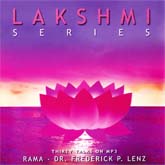
Lakshmi Series
Zen, Taoism and Buddhism
Zen, Taoism and Buddhism. There are many different pathways that lead to spiritual awareness, consciousness and perfection.
Certainly three of the most frequently traveled pathways are the pathways of Zen, Buddhism and Taoism. Today I'd like to talk to you a little bit about these ways, not so much from a historical perspective but from the perspective of one who, in other lifetimes, has practiced and taught these three ways. If you'd like historical information on the evolution of Zen, Buddhism or Taoism, there's a wealth of information at your local library or in a metaphysical bookstore.
Naturally, if you're interested in Taoism, I would suggest that you read The Way of Life by Lao Tzu, the founder of Taoism. I personally prefer the Witter Bynner translation. It's available in paperback.
For Zen, there are many, many books, the Suzuki books and others. I remember a time a number of years ago when you could go into a bookstore and maybe just find four or five books about Zen - Zen Flesh, Zen Bones, Suzuki on Zen and Alan Watts. Now there are many, many more to choose from.
As far as Buddhism is concerned, there are many different books on Buddhism, on Mahayana Buddhism, Vajrayana Buddhism, Hinayana Buddhism. There's a wide variety. Buddhism itself, of course, has evolved and changed quite a bit since the time of Buddha. There are different sects, which are basically different Buddhist religions. Just the evolution of Buddhism, from which Zen also sprang forth, or the evolution of Christianity for that matter, is fascinating to study - to see how an enlightened person will come into the world and present a way, as did Lao Tzu with Taoism or Buddha with Buddhism or Christ with Christianity, and to observe how that way will be modified and changed by the needs of the people and their consciousness level over a period of several thousand years.
But my interest is the essence of these teachings, not so much what's happened with them historically or the books that have been written about them, detailing them, or the descriptions of people who have had experiences in the monasteries or experiences living a more secular life. Rather, my interest is the essence of the teaching - the way, as it were.
Taoism is the way of water. The most frequent element or symbol referred to in Lao Tzu's writings is the symbol of water, and it's the primary symbol that we find throughout The Way of Life. In essence, Lao Tzu suggests that we behave like water. Water, of course, is the symbol of consciousness, pure consciousness. He suggests that we flow like water does. Water always seeks the easiest path, the common level of life. When it reaches a spot where there is a blockage, water finds the easiest path around the blockage. Or, if it can't find a way around the blockage, it continues to assemble. The water gets deeper and deeper until finally the level increases and it flows over the blockage. It uses itself to go beyond whatever it needs to go beyond.
Water gradually wears down even the hardest rocks and stones. The Grand Canyon, of course, is living evidence of the power of water over a period of time. The power of water may not manifest immediately. We don't see these effects right away. We see the little stream of water flowing and we say, well, look at this massive mountain, obviously it's much stronger than this water. Then suddenly, over a period of time, the mountain goes away and the water remains. Water can be very powerful, like a tidal wave - the ocean. It takes on so many different forms. Lao Tzu says that the way of life is water, to be fluid.

